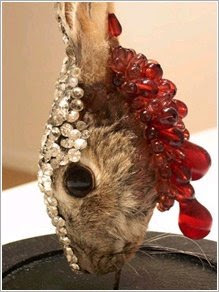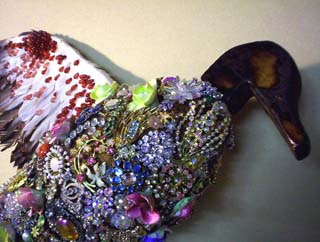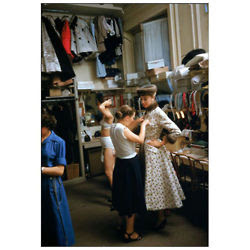
Friday, August 26, 2011
Gaultier couture


A blog just for this beaded Gaultier couture dressn it's just a little bit special and amazing! xoxo Look at all that bead work! So bloddy creative makes my heart pound1 if you don't consider fashion an art I am sorry but I have to consider you Ignorant and suggest you take a look into the history/timeless effert that goes into it all. YAY xoxoxo
Angela Singer British Artist - taxidermy revisited xo






Angela Singer is both artist and animal rights activist, and it only takes a quick glance at some of her pieces to see where those two collide. She recycles old taxidermy (so nothing is ever killed simply for her work) and creates mixed-media installations/sculptures.
Angela Singer is a British artist and animal activist whose confronting artworks have a strong animal rights message particularly commenting on the needless death of hunted animals, and questioning the notion that people are superior to other species. Since the mid 1990s she has explored the human animal relationship, calling into question the unnecessary violence humans subject animals too. Singer often recycles vintage taxidermy in her art. is a British artist and animal activist whose confronting artworks have a strong animal rights message particularly commenting on the needless death of hunted animals, and questioning the notion that people are superior to other species. Since the mid 1990s she has explored the human animal relationship, calling into question the unnecessary violence humans subject animals too. Singer often recycles vintage taxidermy in her art.
RESPECT ANGELA - I salute you and your beautiful works very inspired! xoxoxo
Now i feellike looking into lace with you all xoxo YAY







Lace is an openwork fabric, patterned with open holes in the work, made by machine or by hand. The holes can be formed via removal of threads or cloth from a previously woven fabric, but more often open spaces are created as part of the lace fabric. Lace-making is an ancient craft. True lace was not made until the late 15th and early 16th centuries. A true lace is created when a thread is looped, twisted or braided to other threads independently from a backing fabric.
Originally linen, silk, gold, or silver threads were used. Now lace is often made with cotton thread. Manufactured lace may be made of synthetic fiber. A few modern artists make lace with a fine copper or silver wire instead of thread.
There are many types of lace, classified by how they are made. These include:
Needle lace; such as Kenmare Lace are made using a needle and thread. This is the most flexible of the lace-making arts. While some types can be made more quickly than the finest of bobbin laces, others are very time-consuming. Some purists regard needle lace as the height of lace-making. The finest antique needle laces were made from a very fine thread that is not manufactured today. Check it out! -
http://en.wikipedia.org/wiki/File:The_designers_1889.jpg
Originally linen, silk, gold, or silver threads were used. Now lace is often made with cotton thread. Manufactured lace may be made of synthetic fiber. A few modern artists make lace with a fine copper or silver wire instead of thread.
There are many types of lace, classified by how they are made. These include:
Needle lace; such as Kenmare Lace are made using a needle and thread. This is the most flexible of the lace-making arts. While some types can be made more quickly than the finest of bobbin laces, others are very time-consuming. Some purists regard needle lace as the height of lace-making. The finest antique needle laces were made from a very fine thread that is not manufactured today. Check it out! -
http://en.wikipedia.org/wiki/File:The_designers_1889.jpg
these are the nuns that designed and made the lace! xoxo
Cutwork, or whitework; lace constructed by removing threads from a woven background, and the remaining threads wrapped or filled with embroidery.
Bobbin Lace; as the name suggests, made with bobbins and a pillow. The bobbins, turned from wood, bone or plastic, hold threads which are woven together and held in place with pins stuck in the pattern on the pillow. The pillow contains straw, preferably oat straw or other materials such as sawdust, insulation styrofoam or ethafoam. Also known as Bone-lace. Chantilly lace is a type of bobbin lace.
Tape lace; makes the tape in the lace as it is worked, or uses a machine- or hand-made textile strip formed into a design, then joined and embellished with needle or bobbin lace.
Knotted lace; including macramé and tatting. Tatted lace is made with a shuttle or a tatting needle.
Knotted lace; including macramé and tatting. Tatted lace is made with a shuttle or a tatting needle.
Crocheted lace; including Irish crochet, pineapple crochet, and filet crochet.
Knitted lace; including Shetland lace, such as the "wedding ring shawl", a lace shawl so fine that it can be pulled through a wedding ring.
Knitted lace; including Shetland lace, such as the "wedding ring shawl", a lace shawl so fine that it can be pulled through a wedding ring.
Machine-made; any style of lace created or replicated using mechanical means.
Guipure; The stitching area is stitched with embroidery threads that form a continuous motif. Afterwards, the stitching areas are removed and only the embroidery remains. The stitching ground is made of water-soluble or non heat-resistant material.
mmmmmmmmmmmmmm a bit of lace I belive can make anyone feel like they deserve to feel!
Guipure; The stitching area is stitched with embroidery threads that form a continuous motif. Afterwards, the stitching areas are removed and only the embroidery remains. The stitching ground is made of water-soluble or non heat-resistant material.
mmmmmmmmmmmmmm a bit of lace I belive can make anyone feel like they deserve to feel!
I also think there is a really earthy and graceful quality to the fabirc and what goes into it. ONE SHOULD
Installation Artist Shane Waltener from london - love!

Artist Shane Waltener

Shane Waltener's Crochet Cobwebs. 08 September 2009

Shane Waltener's Crochet Cobwebs. 08 September 2009

Shane Waltener's Crochet Cobwebs. 08 September 2009

Shane Waltener's Crochet Cobwebs. 08 September 2009
Artist statement
‘My art practice draws inspiration from craft traditions. Sculptures, installations and performance work all reference domestic crafts. I am interested in exploring the sculptural and architectural potential of a medium and techniques that allow for a renewed understanding of traditional crafts in a contemporary context.
Another World Wide Web (2011) consists of a series of modular web-like structures knitted in shirring elastic using a traditional Shetland lace technique. I am interested in how the work is moulded and shaped by the nature of the space and architecture where it is installed. Installing these pieces to furnish otherwise redundant or overlooked areas of a building, in-between spaces, I aim to give visitors a new perspective on the museum or gallery.’
‘My art practice draws inspiration from craft traditions. Sculptures, installations and performance work all reference domestic crafts. I am interested in exploring the sculptural and architectural potential of a medium and techniques that allow for a renewed understanding of traditional crafts in a contemporary context.
Another World Wide Web (2011) consists of a series of modular web-like structures knitted in shirring elastic using a traditional Shetland lace technique. I am interested in how the work is moulded and shaped by the nature of the space and architecture where it is installed. Installing these pieces to furnish otherwise redundant or overlooked areas of a building, in-between spaces, I aim to give visitors a new perspective on the museum or gallery.’
Cover by Designer/Artist Cardon Webb
Sergei Parajanov - Director



One of the 20th century’s greatest masters of cinema, Sergei Parajanov in the 1960s made two masterpieces in a row: Shadows of Forgotten Ancestors (1964) and Color of Pomegranates (1968). Both established him as a phenomenon with no analogy in the art world.
Parajanov was born on the January 9, 1924, in Tbilisi, Georgia, USSR, to an ethnic Armenian family. His father was Iosif Parajanian and his mother was Siranush Bejanian. In 1945 Parajanov traveled to Moscow and entered the directing department at VGIK, one of the oldest and most highly respected film schools in Europe, and studied under director Igor Savchenko and later Aleksandr Dovzhenko in Kiev, Ukraine. Parajanov moved to Kiev, where after a few documentaries (Dumka (1957), Zolotye ruki (1957), Natalya Ushviy (1957)) and several narrative films (Andriesh (1954), Ukrainskaya rapsodiya (1961), Tsvetok na kamne (1962)) he created the magnificent “Shadows of Forgotten Ancestors”, which won countless international awards, including the British Academy Award. The success of “Shadows of Forgotten Ancestors” was compared to that of the super influential Battleship Potemkin (1925); however, “Shadows of Forgotten Ancestors” didn’t conform to the standards of Soviet cinema and Parajanov was immediately blacklisted.
He left for Armenia to film the documentary Hakob Hovnatanyan (1967), and then in 1968 he created “Sayat Nova”, his masterpiece. “Sayat Nova” was banned by Soviet authorities, re-edited and re-named “The Color of Pomegranate”. In December of 1973, the Soviet government arrested Parajanov and sentenced him to five years in hard labor camps. A large group of world-famous artists, filmmakers and activists protested and Parajanov was released, but only after having served four horrific years in the Soviet penal system. Poet Louis Aragon’s petition to the Soviet government was instrumental in securing Parajanov’s release.
Parajanov returned to Tbilisi, but the regime continued to keep him away from cinema. During and after prison Paradjanov created extraordinary collages, drawings and numerous other art works, now frequently exhibited worldwide. In 1984, however, political conditions started to change and, with the help of Georgian intellectuals, the government allowed Parajanov to create the multi-award winning Ambavi Suramis tsikhitsa (1984) – 15 long years after “Sayat Nova”.
In 1986 Parajanov made yet another multi-award winning film, Ashug-Karibi (1988), based on a tale by Mikhail Lermontov, and dedicated the film to his friend Andrei Tarkovsky. His stay in prison had crushed his health, however, and he passed away in July of 1990, leaving his final masterpiece “The Confession” unfinished. It survives in its original negative in Parajanov: The Last Spring (1992) by his closest friend Mikhail Vartanov.
Parajanov’s friends and and colleagues such as Federico Fellini, Tonino Guerra, Francesco Rosi, Alberto Moravia, Giulietta Masina, Marcello Mastroianni and Bernardo Bertolucci were among those who grieved his death, yet today Sergei Parajanov remains not very widely known. Few who saw “Shadows of Forgotten Ancestors” or “Color of Pomegranate” have not been forever influenced by the unseen beauty created by the genius.
Parajanov was born on the January 9, 1924, in Tbilisi, Georgia, USSR, to an ethnic Armenian family. His father was Iosif Parajanian and his mother was Siranush Bejanian. In 1945 Parajanov traveled to Moscow and entered the directing department at VGIK, one of the oldest and most highly respected film schools in Europe, and studied under director Igor Savchenko and later Aleksandr Dovzhenko in Kiev, Ukraine. Parajanov moved to Kiev, where after a few documentaries (Dumka (1957), Zolotye ruki (1957), Natalya Ushviy (1957)) and several narrative films (Andriesh (1954), Ukrainskaya rapsodiya (1961), Tsvetok na kamne (1962)) he created the magnificent “Shadows of Forgotten Ancestors”, which won countless international awards, including the British Academy Award. The success of “Shadows of Forgotten Ancestors” was compared to that of the super influential Battleship Potemkin (1925); however, “Shadows of Forgotten Ancestors” didn’t conform to the standards of Soviet cinema and Parajanov was immediately blacklisted.
He left for Armenia to film the documentary Hakob Hovnatanyan (1967), and then in 1968 he created “Sayat Nova”, his masterpiece. “Sayat Nova” was banned by Soviet authorities, re-edited and re-named “The Color of Pomegranate”. In December of 1973, the Soviet government arrested Parajanov and sentenced him to five years in hard labor camps. A large group of world-famous artists, filmmakers and activists protested and Parajanov was released, but only after having served four horrific years in the Soviet penal system. Poet Louis Aragon’s petition to the Soviet government was instrumental in securing Parajanov’s release.
Parajanov returned to Tbilisi, but the regime continued to keep him away from cinema. During and after prison Paradjanov created extraordinary collages, drawings and numerous other art works, now frequently exhibited worldwide. In 1984, however, political conditions started to change and, with the help of Georgian intellectuals, the government allowed Parajanov to create the multi-award winning Ambavi Suramis tsikhitsa (1984) – 15 long years after “Sayat Nova”.
In 1986 Parajanov made yet another multi-award winning film, Ashug-Karibi (1988), based on a tale by Mikhail Lermontov, and dedicated the film to his friend Andrei Tarkovsky. His stay in prison had crushed his health, however, and he passed away in July of 1990, leaving his final masterpiece “The Confession” unfinished. It survives in its original negative in Parajanov: The Last Spring (1992) by his closest friend Mikhail Vartanov.
Parajanov’s friends and and colleagues such as Federico Fellini, Tonino Guerra, Francesco Rosi, Alberto Moravia, Giulietta Masina, Marcello Mastroianni and Bernardo Bertolucci were among those who grieved his death, yet today Sergei Parajanov remains not very widely known. Few who saw “Shadows of Forgotten Ancestors” or “Color of Pomegranate” have not been forever influenced by the unseen beauty created by the genius.
Juno Reactor - God Is God Sayat Nova (The Colour of Pomegranates), 1968 (dir. Sergei Parajanov)
Sayat Nova (The Colour of Pomegranates), 1968 (dir. Sergei Parajanov) - related to blog below people xoxoxoxo
Sayat Nova - (The Colour of Pomegranates), 1968 Sergei Parajanov

One of the greatest masterpieces of the 20th century, Sergei Parajanov’s The Color of the Pomegranate, a biography of the Armenian troubadour Sayat Nova (King of Song) reveals the poet’s life more through his poetry than a conventional narration of important events in Sayat Nova’s life. We see the poet grow up, fall in love, enter a monastery and die, but these incidents are depicted in the context of what are images from Sergei Parajanov’s imagination and Sayat Nova’s poems, poems that are seen and rarely heard. Sofiko Chiaureli plays 6 roles, both male and female, and Sergei Parajanov writes, directs, edits, choreographs, works on costumes, design and decor and virtually every aspect of this revolutionary work void of any dialog or camera movement.
Thursday, August 25, 2011
Sunday, August 14, 2011
La lune a un mètre - Melies (1898)
( the moon at arms length)
Pretty pretty rad and lovely and delicious ALL OF IT! I love the moon I am surrounded by moon hearted loves and people I am very luck indeed! there for thank you moon and I share this with you all xoxox
La lune à un mètre(The Moon at One Meter)Also known as The Astronomer’s Dream; or, The Man in the Moon in the USA : [An Astronomer’s Dream](1898) FrenchB&W : Short filmDirected by Georges Méliès
Cast: [?] Georges Méliès?
Méliès Star-Film production. / Produced by Georges Méliès. /35mm spherical format / Frazer reel numbers 160-162
Survival Status: Print exists.
Subscribe to:
Posts (Atom)























